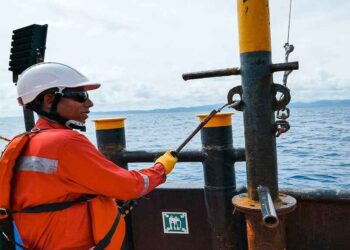The recent executive order temporarily halting US offshore wind development happens to create a sense of uncertainty for the industry and can very well jeopardize the ambitious renewable portfolio benchmark rules of some states within the Northeast region. Due to the high offshore wind speed, there are many states across the region that have mandated the procurement when it comes to offshore wind generation. Holding the offshore wind development will easily compel the states in the PJM Interconnection LLC, the New York ISO, and ISO New England to substitute certain other energy sources such as storage, gas, and solar. It is well to be noted that the US offshore wind development of states in PJM amounts to 25.9 GW, thereby accounting for just 13% of the estimated 2040 peak demand, whereas ISO-NE’s 11.6 GW target is 39% when it comes to its demand.
Over three-quarters of NYISO’s 9 GW of mandated offshore wind capacity is not needed until 2035, thereby allowing for a longer timeline in order to meet the renewable portfolio standard goals.
States when it comes to the Northeast region are going to leverage solar, storage as well as gas capacity in order to compensate when it comes to the decrease within offshore wind capacity with the right supply mix, which goes on to vary by location.
Solar as well as onshore wind resources stand to gain due to the reduction in offshore wind generation, since solar, along with wind curtailment, reduces and elevates the energy revenue.
The reduction when it comes to offshore wind is going to delay but not derail the state’s overarching RPS objectives, with RPS mandates being met mostly around 3 to 4 years later. But a share of generation when it comes to clean energy remains comparatively balanced over the forecast horizon.
The state-level US offshore wind development targets when it comes to PJM touch a massive 25.9 GW by 2040, led by New Jersey & Maryland with respective targets of 11 GW by 2040 and 8.5 GW by 2030.
It is well to be noted that the offshore wind target of Virginia of 5.2 GW by 2034 gets included within the PJM target since the operating coastal Virginia offshore wind project happens to be interconnected to PJM. While PJM has the most ambitious offshore wind objective when it comes to the independent system operators considered there, the executive order may not look as disruptive to its energy mix since its overall target in 2040 represents just 13% of the total peak demand that year.
In contrast to this, ISO-NE’s overall offshore wind RPS target of 11.6 GW throughout its member states includes a substantial 39% of its estimated demand in 2040. Sans the offshore wind, ISO-NE will have to supplement energy generation with other kinds of renewable sources in order to meet the RPS guidelines.
The NYISO objective of 9 GW by 2035 comprises 26% of its anticipated peak demand that year. Interestingly, over three-quarters of the capacity is not needed until 2035, thereby offering NYISO a much longer timeline in order to achieve its RPS offshore wind objectives. Moreover, the interim target of 1.4 GW is anticipated to be met by 2026 because of the existing offshore wind projects that are at present under construction and those that have power purchase agreements. Because of NYISO‘s long runway, there is no examination of charges in its capacity mix that has been done in detail.
So as to understand the actual impact when it comes to reduction in offshore wind generation because of the executive order, one has to compare the Q3 2024 market indicative power forecast to a scenario that eradicates the existing offshore wind projects without having a PPA and assume that the RPS offshore wind objectives are not reached. The overall removed planned offshore wind capacity is 0.8 GW in PJM, 3.9 GW in ISO-NE, and 1.3 GW when it comes to NYISO.
When it comes to ISO-NE, the expected deduction of 11.6 GW of mandated offshore wind generation is going to be overcompensated for due to the addition of 18.2 GW of solar capacity as well as 2.7 GB of energy storage. The onshore wind capacity, however, remains the same between both forecasts. The region goes on to benefit from a balanced supply of onshore wind, nuclear, and hydroelectric generation in addition to the healthy reserve margins at the outset of the forecast. This kind of diverse energy mix goes on to mean that there would be no additional gas capacity, which will be required in order to maintain the dependence. It is worth noting that 1.4 GW of the present gas happens to remain online. The rise in solar penetration will elevate arbitrage opportunities, thereby leading to a more regular charging as well as discharging of storage systems.
When it comes to the NYISO, the change in terms of capacity as well as generation is going to be very, very similar to what is shown in ISO –NE, with 10 GW of solar capacity that gets added and 1.2 GW of gas that is not retiring. This goes on to offset the 9.0 GW of reduced target offshore wind capacity. However, it also decreases the reserve margins since the effective load-carrying capacity when it comes to solar happens to be less than that of offshore wind.
It is worth noting that PJM is anticipated to generate 25% of energy coming from wind by 2040 and maintain a reserve margin of 18%, which is just above the 17.8% objective. If we compare it, iso-ne boasts a much higher generation share of 50% coming from wind and a more robust 34% reserve margin. Because of tight reserve margins along with lower wind penetration, PJM will have to construct another 0.5 GW of gas capacity and 5 GW of storage capacity in order to compensate for the low offshore wind generation during those non-sunny hours. Around 10 GW of additional onshore wind capacity will also have to be built with almost 2.6 GW loss in terms of renewable capacity from decreasing the RPS offshore wind mandate, which is still a kind of net reduction in overall wind generation.
This kind of an alteration within the supply mix goes on to mean a shift from hybrid solar to standalone storage happens to be required when it comes to dependability, thereby ultimately decreasing the solar capacity and transitioning the amount of charging as well as discharging that typically capitalizes when it comes to lower daytime energy prices to the overnight hours. The forecast reserves, however, remain stable since the gas and storage capacity, which are required for dependability, decrease because of the higher ELCC value as compared to wind and solar.
The effect of decreased offshore wind generation is more pronounced within PJM, in which changes within gas generations are prominent. The existing as well as previously forecast gas generation takes advantage of the decrease in offshore wind resources. In ISO-NE, where onshore wind happens to be plentiful, solar power plants happen to see a greater revenue advantage and are driven due to rising storage arbitrage as well as a notable uptick when it comes to solar output. Solar plants within NYISO would also witness better revenue benefits as their generation goes on to rise.
It is well to be noted that reduced offshore wind is going to delay but not derail the state’s overarching RPS objectives. States such as Massachusetts and Connecticut in ISO-NE, as well as the District of Columbia, New Jersey, and Delaware within PJM, are going to meet their RPS mandates, probably 3 to 4 years later.
The reduction when it comes to offshore wind generation within the ISO-NE goes on to create headroom as far as solar and wind generation is concerned, thereby decreasing their curtailment. In the present scenario, the wind curtailment is anticipated to be 12% by 2040, which is a decrease of almost 9 percentage points, whereas solar curtailment gets reduced by 5 percentage points.
When it came to the PJM, the curtailment levels happened to be already low, and the requirement for new capacity got driven due to data-driven datacentre load rise, which itself means tighter reserve margins, which would be anticipated in the coming term. The eradication of offshore wind sources decreases the wind curtailment, and the associated dip within solar capacity goes on to contribute in terms of lower solar generation curtailment.
Both solar as well as wind resources in PJM and ISO –NE are all set to gain due to the reduction when it comes to offshore wind generation, since more of their output is most likely to be required by power end users, thereby raising the energy revenue.
Even due to the reduction when it comes to curtailment, the percentage of overall clean energy generation goes on to remain comparatively stable in ISO-NE within this forecast horizon, whereas the PJM experiences a very slight dip because of increased gas generation, which compensates for the loss as far as overnight power from offshore wind sources is concerned.
It is well to be noted that the offshore wind development was already going through challenges post-Covid because of the fact that contracts were needed for renegotiation in order to adapt to the economic climate of supply chain disruptions as well as cost increases. Some of the prominent examples include the Sunrise Wind I & II offshore wind farm, Boardwalk Offshore Wind, and, more recently, the Atlantic Shores Offshore Wind LLC.
The shift by President Trump in energy policy as compared to his predecessor has gone on to create more uncertainty for investors within renewable energy. The January 20, 2025, executive order that paused offshore wind development has had immediate effects, like objections from the Long Beach Island group, which has resulted in the Environmental Appeals Board going ahead and demanding the Atlantic Shores Environmental Protection Agency clean air permit. The EPA has gone on to request this remand to reassess the project, with the offshore wind presidential memorandum offering context as well as support for the request.
In addition to this, the Trump administration’s interior secretary has gone on to issue a new order in April, which directs the Empire Wind 1 offshore project’s construction to get halted by directly challenging the New York state energy policies.
In spite of these kinds of challenges, the owners of the project, which happened to be either under construction or not scheduled for completion until 2030 or later, are related to giving away power to states with a favorable view in terms of offshore wind that remains confident in their investment. This sort of a temporary hold within offshore wind development goes on to pose a major challenge for Northeast states, which are indeed striving to meet their RPS objectives. The ripple effects are going to be felt throughout the energy spectrum since investors, as well as operators, alter their strategies as well as supply mix so as to respond to the changing scenarios.


















































